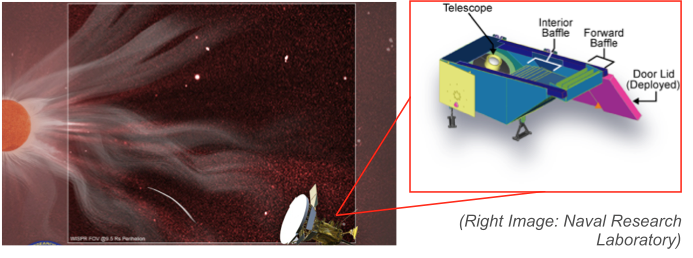
There are numerous companies and institutions that have contributed to the success (so far) of the launch of NASA's Parker Solar Probe vehicle, such as the U.S. Naval Research Laboratory’s (NRL) Wide-Field Imager for Solar Probe (WISPR), or the 'eyes', of the probe. As one of the mission partners, NRL provides in-depth understanding and operation of sun-viewing telescopes essential to the probe’s primary mission, which will be the closest to go to the Sun...“Because of the fact that this is the only imager on the probe, we are the eyes of the spacecraft.”
The NRL will provide NASA with mission operations and data analysis during the solar probe’s 24 orbits around the sun that spans over a seven-year period.
“NRL is very well known on the solar side for building coronagraphs and heliospheric imagers,” said Dr. Nour Raouafi, deputy project scientist for Parker Solar Probe. “These types of instruments are extremely important when it comes to space weather. Space weather is important for civilians, the Navy and all militaries. We need it and depend on it.”
“Because of the fact that this is the only imager on the probe, we are the eyes of the spacecraft,” said Dr. Russell Howard, NRL head of flight project section in solar and heliophysics branch. “We can say to the community of other experimenters that this is what you’re looking at, and this what you’re measuring.”

Artist’s impression of the SPP spacecraft at closest approach to the Sun with the WISPR field of view superimposed. The opto-mechanical layout of NRL’s WISPR is shown on the right.
According to Howard, NRL was the organization that first founded the existence of coronal mass ejections, and he has worked within the group studying the solar phenomenon since 1971.
“Imagine if something erupts on the sun and is hurdling towards us,” said Raouafi. “Telecommunications would be interrupted, and satellite equipment could sustain severe damage. If a big event occurs it could shut down the entire power grid.”
According to Howard, with the evidence from the research done since 1971, there is a direct correlation between coronal mass ejections, geomagnetic storms and Earth’s ionosphere.
“The importance of instruments such as WISPR gives us the ability to look to the sun and decipher what is going on there and what is heading our direction,” said Raouafi.
The U.S. Naval Research Laboratory provides the advanced scientific capabilities required to bolster this country’s position of global naval leadership. With more than 2,500 personnel scientists, engineers and support staff, it has served the U.S. Navy and the nation for nearly 100 years, thus advancing research.
Source: US Navy

